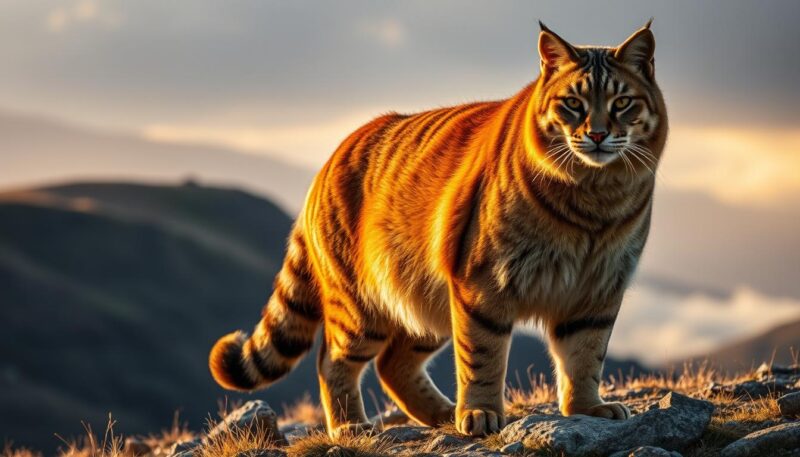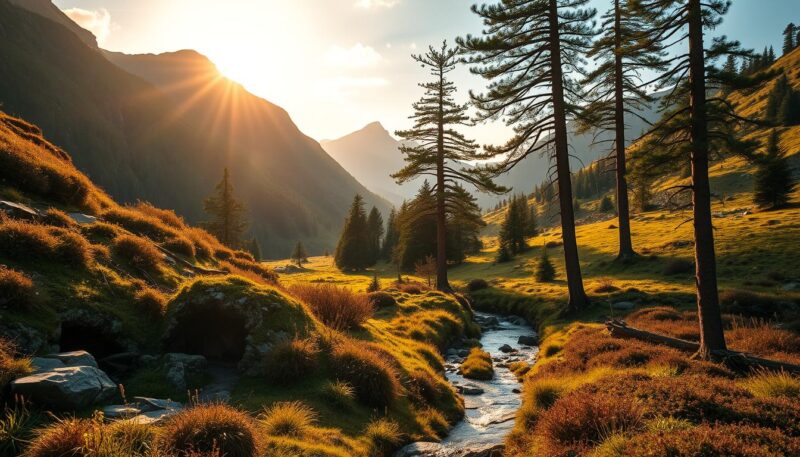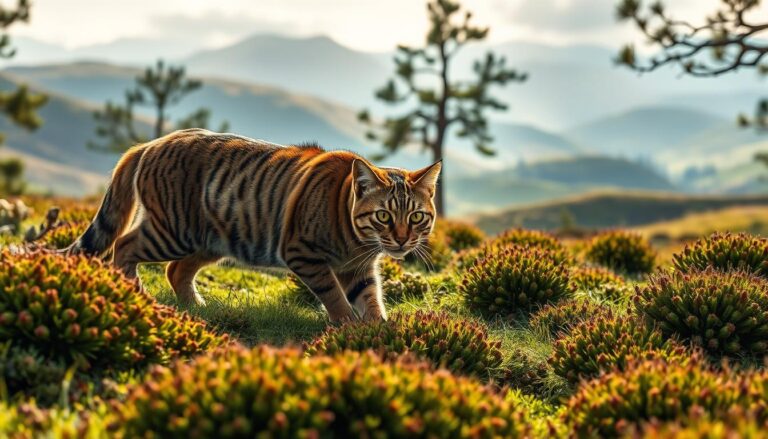Did you know the Scottish wildcat, like the Highland Wildcats, is very rare? There are fewer than 200 left. This shows how important it is to save these cats.
These cats live in Scotland’s remote highlands. They look different from regular cats, with a sturdy build and wide features. They also help keep their habitats healthy.
But, they face big dangers like losing their homes and mixing with domestic cats. Knowing about these cats and their struggles is key to helping them survive.
Understanding the Highland Wildcats’ Characteristics
The Highland Wildcats are known for their special physical traits and patterns. These traits make them different from regular domestic cats. They have a strong build and hunting skills, perfect for their natural habitats.
Knowing about these features is key for protecting them. It also helps in spotting this rare breed in the wild.
Physical Attributes
Male Highland Wildcats weigh 5-8 kg, while females weigh 3-5 kg. They are very muscular, built for hunting rabbits and rodents. Their fur is thick and usually grey with black stripes.
Unlike domestic cats, Highland Wildcats look more alike. Their uniform appearance shows they are well-suited to the wild.
Distinctive Patterns
The patterns on Highland Wildcats are unique and help identify them. Their stripe patterns are not only beautiful but also useful for research. Scientists use a scoring system to tell them apart from domestic cat hybrids.
This system looks at the number of dark stripes, tail color, and fur quality. It highlights the importance of their wildcat traits.

The Habitat and Distribution of Highland Wildcats
Highland Wildcats live in various terrains, which shape their homes and where they can be found. They like forests, river valleys, and moorlands, especially below 650 meters. This choice is key because it affects their food, like rabbits and voles.
Preferred Environments
These wildcats prefer places with cover and chances to hunt. Dense vegetation helps them sneak up on their prey. They like:
- Wooded areas for shelter.
- Open moorlands for hunting.
- Freshwater river valleys for a rich ecosystem.
These places help them survive and reproduce.
Current Range
Highland Wildcats once lived across much of Britain. But, human actions have shrunk their home. Now, they mainly stay in the northwest Highlands of Scotland. Places like the Cairngorms and Ardnamurchan Peninsula are their strongholds.
Conservation efforts are underway to learn more about them. It’s hard because they are hard to find. Knowing where they are is key to protecting them.

Challenges Facing Highland Wildcats
Highland Wildcats face big challenges that threaten their survival. These challenges make conservation efforts harder. Hybridization risks and environmental pressures are key issues.
Hybridization Risks
Hybridization with domestic cats is a big threat. It mixes their genes, making it hard to keep wildcat populations pure. This mixing makes it tough to save their unique traits.
Conservation efforts need to protect them from domestic cats. This is crucial to keep their genetic line alive.
Environmental Pressures
Environmental pressures add to the Highland Wildcats’ problems. Urban development takes away their habitats. Road traffic increases accidents and splits their populations.
Competition for food from livestock makes things worse. Studies show less food means more deaths. These issues demand quick action to save these amazing animals.
Conclusion
The Highland Wildcats are a rare and endangered species in Scotland. They play a big role in the country’s biodiversity. To save them, we need to focus on restoring their habitats and breeding programs.
These efforts help keep the Highland Wildcats’ genetic diversity strong. This is key to their survival against environmental challenges.
Public awareness is crucial for saving the Highland Wildcats. Protecting them means preserving Scotland’s cultural heritage and ecological balance. With threats growing, it’s vital to educate people and get them involved in conservation.
Scotland must keep working to save the Highland Wildcats. We need to make sure future generations can see these amazing animals in the wild. This will protect their legacy and Scotland’s natural beauty.

